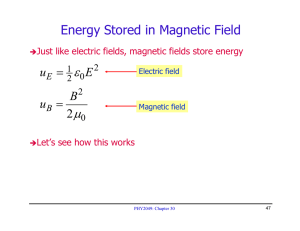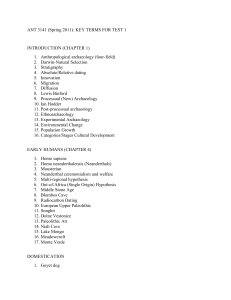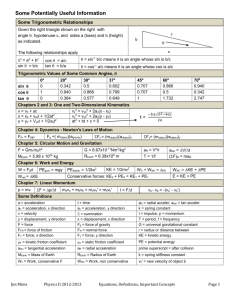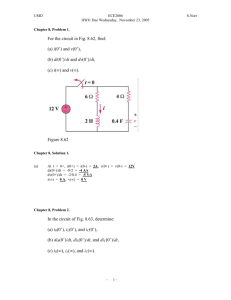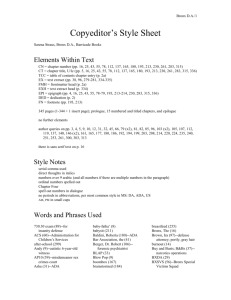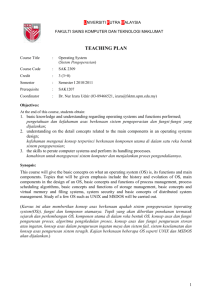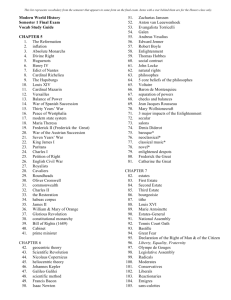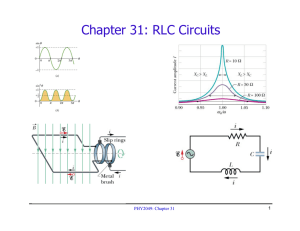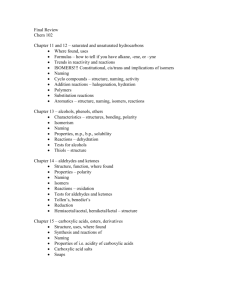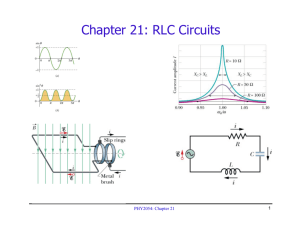Energy Stored in Magnetic Field ε μ
advertisement
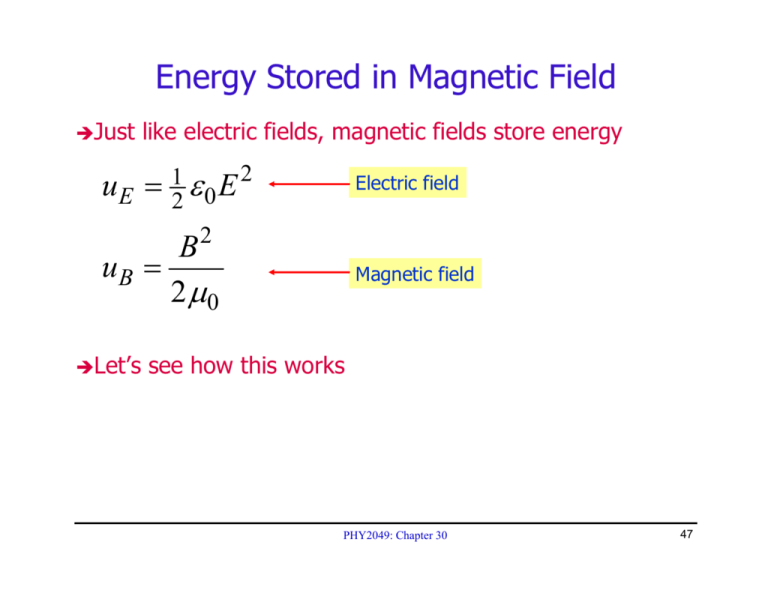
Energy Stored in Magnetic Field ÎJust like electric fields, magnetic fields store energy uE = 1 ε E2 2 0 2 Electric field B uB = 2μ0 ÎLet’s Magnetic field see how this works PHY2049: Chapter 30 47 Energy of an Inductor Î How much energy is stored in an inductor when a current is flowing through it? Î Start with loop rule ε = iR + L di dt Î Multiply by I to get power equation ε Î Î Î di I = i R + Li dt 2 Identify PL, the rate at which energy is being stored in the inductor Identify energy stored in inductor Similar to capacitor: U C PL = dU L di = Li dt dt 1 2 U L = ∫ Lidi = Li 2 q2 = 2C 48 Energy in Magnetic Field (2) ÎApply UL = ÎUse l to solenoid (constant B field) 1 2 Li 2 = 1 2 ( ) μ 0 n 2 lA i 2 r formula for B field: B = μ 0 ni N turns 2 B UL = lA 2μ0 UL ÎCalculate energy density: u B = V B2 uB = 2μ0 ÎThis B field V = Al u E = 12 ε 0 E 2 E field is generally true even if B is not constant PHY2049: Chapter 30 49 Energy Calculation Examples ÎCalculate uB for earth field, B = 5 x 10-5 T ( −5 ) 2 5 × 10 B2 −3 3 uB = = 10 J/m 2 μ 0 2 × 4π × 10 − 7 ÎCalculate uB for neutron star, B = 108 T ( ) 8 2 10 B2 21 3 = × uB = 4 10 J/m 2 μ 0 2 × 4π × 10 − 7 ÎCalculate uB for magnetar, B = 1011 T ( 11 ) 2 10 B2 27 3 = × uB = 4 10 J/m 2 μ 0 2 × 4π × 10 −7 Equivalent mass density uB 10 3 ρ = 2 4 × 10 kg/m From E = mc2 c PHY2049: Chapter 30 50 Web Sites ÎOriginal magnetar discovery http://science.nasa.gov/newhome/headlines/ast20may98_1.htm http://www.firstscience.com/site/articles/solarflares.asp ÎMore recent magnetar discovery (Feb. 2005) http://www.physorg.com/news3112.html ÎOnline articles on magnetars http://solomon.as.utexas.edu/~duncan/magnetar.html http://www.space.com/scienceastronomy/magnetar_formation_05 0201.html http://apod.gsfc.nasa.gov/apod/ap041126.html ÎArticles on neutron stars (second one has videos_ http://www.astro.umd.edu/~miller/nstar.html http://antwrp.gsfc.nasa.gov/htmltest/rjn_bht.html PHY2049: Chapter 30 51 Gigajoule Magnet at CERN ÎCMS experiment at CERN p-p collisions at world’s highest energy in 2007 Hope to discover new particles, find the origin of mass and new fundamental forces Compact Muon Solenoid PHY2049: Chapter 30 52 Human PHY2049: Chapter 30 53 CMS Experiment Magnet ÎLarge central solenoid magnet to study particle production B = 4T, R = 3.15 m, L = 12.5 m UB = 2.6 x 109 J = 2.6 gigajoules!! UB ( ) B2 42 2 lA = 3.15 = π × (12.5 ) − 7 2μ0 2 × 4π × 10 http://www.spacedaily.com/news/energy-tech-04b.html PHY2049: Chapter 30 54 CMS Articles and Pictures ÎHome page http://cmsinfo.cern.ch/Welcome.html/ ÎPictures of detector http://cmsinfo.cern.ch/Welcome.html/CMSdetectorInfo/CMSdetect orInfo.html http://cmsinfo.cern.ch/Welcome.html/CMSmedia/CMSmedia.html ÎInteresting article on solenoid, with pictures http://cmsinfo.cern.ch/Welcome.html/CMSdocuments/MagnetBroc hure/MagnetBrochure.pdf ÎOther documents & pictures about CMS http://cmsinfo.cern.ch/Welcome.html/CMSdocuments/CMSdocume nts.html PHY2049: Chapter 30 55 Transformers ÎPurpose: change alternating (AC) voltage to a bigger (or smaller) value Input AC voltage in the primary produces a flux Changing flux in secondary induces emf dΦB Vp = N p dt dΦB Vs = N s dt Ns Vs = V p Np PHY2049: Chapter 30 56 Transformers ÎNothing comes for free, however! Increase in voltage comes at the cost of current. Output power cannot exceed input power! power in = power out i pVp = isVs is V p N p = = i p Vs N s PHY2049: Chapter 30 57 Transformers: Sample Problem ÎA transformer has 330 primary turns and 1240 secondary turns. The input voltage is 120 V and the output current is 15.0 A. What is the output voltage and input current? Ns ⎛ 1240 ⎞ Vs = V p = 120 ⎜ ⎟ = 451V Np ⎝ 330 ⎠ i pV p = isVs “Step-up” transformer Vs ⎛ 451 ⎞ i p = is = 15 ⎜ ⎟ = 56.4 A Vp ⎝ 120 ⎠ PHY2049: Chapter 30 58 Transformers ¾ This is how first experiment by Faraday was done ¾ He only got a deflection of the galvanometer when the switch is opened or closed ¾ Steady current does not make induced emf. PHY2049: Chapter 30 59 Applications Microphone Tape recorder PHY2049: Chapter 30 60 ConcepTest: Power lines ÎAt large distances, the resistance of power lines becomes significant. To transmit maximum power, is it better to transmit (high V, low i) or (high i, low V)? (1) high V, low i (2) low V, high i (3) makes no difference Power loss is i2R PHY2049: Chapter 30 61 Electric Power Transmission i2R: 20x smaller current ⇒ 400x smaller power loss PHY2049: Chapter 30 62
